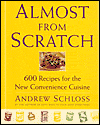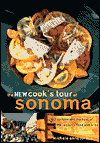
(Photo from livegourmet.com, a company that produces watercress.)
If I owned a restaurant, this would probably be my signature dish. I'm sorry I don't have a photo of the really pretty platter of food it makes with all the grilled vegetables around the outside. This photo above looks a lot like my grilled salmon with watercress. I've made this so often that I might be able to make it in my sleep. And it is my one-and-only recipe for which I can buy the ingredients in the late afternoon and have dinner on the table by 6:30 or 7:00 - for guests. This is a one dish meal - well, clarify that . . . it's a grill in one meal. Except for dessert and appetizers, if you're serving them, you can make this in no time at all. It may be the only recipe in my entire personal cookbook that qualifies. So, take note, if you'd like a company meal with little effort.
My friend Stacey is a good cook, but doesn't really like spending hours in prep, nor does she have time anymore with two little ones getting into mischief. But after I made this at their house in the Bay Area one weekend several years ago, she said they invited lots of friends over and she got a lot of entertaining done - serving this for every one. So, Stacey, this one's dedicated to you! You're my hero!
I've told you before about Chris Schlesinger. His book,
The Thrill of the Grill, is one of my favorite cookbooks. This recipe came from there. This is the fellow I spoke to, telling him my favorite recipe from his book was the Asian Slaw and he gave me this
face. If you haven't read that story, click
here. When he signed my cookbook, I hadn't prepared this salmon dish yet. I just wish Chris was reading my blog and he'd know that
this is my favorite recipe to date. And I've amplified on his recipe too. I've thought about writing to him tell tell him all about what I've done to his recipe. But oh well. He's a famous chef and all. I think I won't.
For awhile, some years ago, I cut down the amount of the dressing on this salad, to reduce the total fat grams, but have since decided that the full amount is needed; it's an important component of the dish so it covers the salad sufficiently and you have enough left over to pour a little over the salmon itself. And if you grill vegetables to go with, like I do, then you need a bit more for them too. Salmon has plenty of fat in its tissues, but it's good fat, so don't be thrown by the fat content on this one. I've done the math and the salad dressing is fairly inconsequential.
I do need to talk a bit about watercress. It's a little hard to find - at least it is here in California. Whole Foods sells some funny kind of young watercress still growing in vermiculite covered in a little root ball. It has different roundish leaves. And has almost no flavor. This is NOT what you want for this. You need the real thing, the kind of watercress that's actually grown in water (that's why it's called watercress, silly!). It has fattish stems (which you don't use in the salad) and wonderful crinkly leaves. The taste is peppery, not to everyone's taste, I suppose. I love it, though. So seek out good, fresh watercress.
Costco sells this huge slab of boneless salmon. It is farm-raised; not my favorite thing anymore, but I will buy it on occasion. I prefer wild caught now, and if you can find it, by all means do so! You wipe it off, spray it with olive oil spray, then place it on two large pieces of greased heavy-duty aluminum foil, crimp up the edges around the salmon (you don't seal it or cover it). Add a bit of salt and pepper. Meanwhile, you fire up your grill and start working on the vegetables, whichever ones you decide to use. I like putting something red with this dish - the color is just glorious on a large platter. So, you need red bell peppers for sure, even yellow or orange ones too. Asparagus works also. And zucchini too. In a pinch I've also thrown a large quantity of halved cherry tomatoes on the platter at the end (not grilled, of course). And DH's favorite is small red onions, halved. All the vegies need to be well oiled, then grilled. Then you put on the salmon and it's done when you begin to see some white foam seep up through the middle of the salmon. At the last minute toss the watercress salad with some of the dressing, spread it down the middle of the large platter, then slide the salmon off the foil and on top of the salad and add the grilled vegies (that you've kept hot) around the edges. Serve immediately to raves. Guaranteed.
Grilled Salmon with Watercress Salad
Recipe: adapted from "The Thrill of the Grill" cookbook
Servings: 6
2 1/2 lb salmon fillet -- max 1" thick
DRESSING:
2 bunches watercress
1/2 medium red onion -- thinly sliced
2 tablespoons sesame oil
1 teaspoon sugar
2 tablespoons soy sauce
1 tablespoon fresh ginger root -- minced
2 tablespoons rice wine vinegar
2 tablespoons red wine vinegar
4 tablespoons olive oil salt and pepper -- to taste
2 tbsp sesame seeds -- toast in teflon pan
VEGIES (optional):
3 whole red onions -- peeled, halved or quartered
2 pounds asparagus
4 whole red bell pepper -- quartered
1. Heat a non-stick pan and toast the sesame seeds, stirring occasionally, until golden brown. They tend to burn quickly, so stir often when they start to brown.
Salad: wash well the bunches of watercress and pull the small stems off and discard the large stems. Dry in a towel. Place watercress and red onion in a plastic bag and keep until ready to serve.
2. Vinaigrette: combine the oil, sugar, soy sauce, ginger, vinegars, olive oil and salt and pepper to taste. It is best if this is allowed to sit for a few hours, refrigerated, before dressing the salad.
3. If using vegetables, prepare them, oil them, then grill to your taste, being careful not to burn. Move to the side before they're completely done and add the salmon.
4. Fish: Spray the top of the salmon with olive oil spray. Using either heavy-duty foil, or two layers of regular foil, spray the foil with olive oil spray, then place fillet on foil and curl up edges to make a sort of a "pan." Place on grill for 12-20 minutes, or until the inner juices of the salmon have begun to bubble up in the meat (whitish fluid).
5. Immediately before serving, in a large bowl combine the watercress and onion and add most of the vinaigrette to taste - really, taste it to make sure it's right. Sometimes I add green and/or red leaf lettuce to the salad mixture as well. Pour the salad out onto a large platter and place the hot, grilled fish on top. Pour the remaining vinaigrette over the top of the salmon and sprinkle with the toasted sesame seeds and serve. It says this is excellent served cold although we've never done it that way.
6. NOTE: This is also excellent made with halibut or swordfish. The salmon is the best, however. Serving Ideas : Good for a hot, summer night. I've served this with asparagus, simply dressed with seasoned rice wine vinegar sprinkled over the spears, or green beans. Sometimes I also decorate the platter with halved cherry tomatoes, to give it some color. Or, more often, we grill red and yellow peppers (sprayed lightly with olive oil spray) and place them around the outside of the platter. If you do the peppers, grill them before you put on the salmon, then push them off to the side when you put the salmon on. We also like to add red onions (quartered, sprayed with olive oil) to the platter - they should go on the grill first, as they can take 30 or more minutes. NOTES : This is really a fairly simple dish. Everything can be done ahead except grilling the fish.
Per Serving: 441 Calories; 22g Fat (44.4% calories from fat); 42g Protein; 20g Carbohydrate; 6g Dietary Fiber; 98mg Cholesterol; 481mg Sodium. Exchanges: 0 Grain(Starch); 5 1/2 Lean Meat; 3 Vegetable; 3 Fat; 0 Other Carbohydrates.
To view a printable recipe, click on title at top.


























